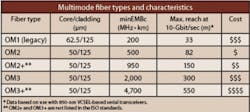Data centers are fiber-rich environments in both their local area networks and their strorage area networks. The TIA-942 standard addresses cabling issues within the data center.
Click here to enlarge imageWhich fiber choice(s) would be best for this application?Starting with the backbone, OM2 fiber can carry 10-Gbit/sec up to 82 m, so the 30-m backbone links would not need to be replaced. Over the horizontal to the high-end stations, all four 50-µm fiber grades (OM2, OM2+, OM3, and OM3+) have the necessary reach to achieve 10-Gbits/sec at 50 m. With cost as the differentiating factor, OM2 would be the most cost-effective choice. At longer reaches, more expensive OM2+ or OM3 grades would be necessary to achieve 10-Gbit/sec.Under this architecture, OM3+ is a cost-prohibitive choice at any length.A common design option under this architecture, and fiber-to-the-desk, is to mix different grades of 50-µm fiber to leverage existing fiber investments. Mixing fiber links does not impact 10-Gbit/sec performance across the channel, but it does affect reach. Specifically, the 10GBase-S standard channel length of 300 m over OM3 is shortened by a predictable amount for each link of OM2 or OM2+ fiber in the channel. (The exact method for calculating adjusted reach is outlined in a technical reference document, TR25, at www.panduit.com.)Example 2: Installing a new FTTE system. A new six-story building is being constructed, and a network must be installed that can support the speed and bandwidth of users over the next 10 to 15 years, starting with immediate 10-Gbit/sec capability. An FTTE architecture is selected for the new network, with permanent links of about 100 m that extend from the main equipment room to the telecommunications enclosures located on each floor at or near the workstations.Which fiber choice(s) would be best for this application?At a reach of 100 meters, OM2+ is the most cost-effective fiber choice and will carry 10-Gbits/sec reliably across a 100-m link. (The shorter reach of OM2 at 10-Gbit/sec limits its application here.) OM3 is required for links that extend more than 150 m, and has the added value of twice the bandwidth of OM2+ at slightly higher cost.Example 3: Enhancing a data center. Short horizontal channels (up to 60 m) are being added to the SAN side of the data center to facilitate a buildout of 2-Gbit/sec Fibre Channel switches and storage hardware. It is desired to “futureproof” this solution for growth to 10-Gbit/sec Fibre Channel.Which fiber choice(s) would be best for this application?For data rates up to 10 Gbits/sec, OM3 is the first fiber to consider because it is specifically recommended under TIA-942. By using OM3 as the fiber standard throughout the data center, the system gains the design flexibility to deploy large numbers of connections in each channel. Such OM3 systems also can support both very long-reach channels and existing OM2 fiber applications throughout the network. But cabling links in the data center can be short (< 50 m), so OM2+ fiber can be used and/or existing runs of OM2 fiber may be repurposed as less-expensive solutions than OM3. (It is worth noting that OM2+ extended-reach fiber is not listed in the ISO standard and may not support next-generation services.)For “futureproofing” the data center beyond 10 Gbits/sec, OM3 or OM3+ fiber are expected to be required. Recently, several manufacturers have begun to move beyond current IEEE 10-Gbit/sec standards and work on defining two-fiber coarse wavelength division multiplexing (CWDM) transceivers to carry signals at speeds of 40 Gbits/sec and potentially 100 Gbits/sec. One of the design goals is to repurpose OM3 fiber for use with a 40-Gbit/sec CWDM serial multimode PMD, but OM3+ may be required for use with a 100-Gbit/sec serial multimode PMD.Strength trainingSelecting the best fiber type is a much easier process once you know the strengths of each multimode grade as well as the options for installing them under the applicable standards. Whether you are upgrading your network or futureproofing the performance of a new data center, these guidelines will help you design flexible, scalable, and cost-effective multimode fiber infrastructures. ROBERT REID is product development manager with Panduit Corp. (www.panduit.com).


